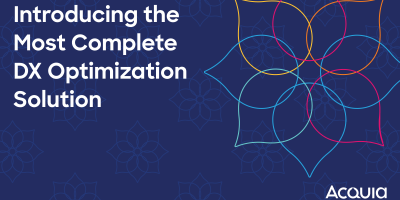Tackling Marketing's Challenges with Data-Driven DXO Strategies

The marketing landscape is currently under economic scrutiny, with Gartner’s 2024 CMO Spend Survey indicating marketing budgets have been trimmed to 7.7% of company revenue. Concurrently, CEOs are sharpening their focus on growth, compelling marketing teams to find innovative strategies to enhance productivity and show greater returns on marketing spend.
How are marketers going to achieve this? By optimizing the most critical element of a productive customer experience: content. And it’s not just about how to scale content production, but how to ensure you are putting the right piece of content in front of the right audience at the right time, at every step of their customer journey.
With a digital experience optimization (DXO) solution, you have the ability to look at the digital journey as a whole – understanding how customers engage with you and why they make certain decisions, so you can craft customer-centric journeys that address customer needs at every stage. A DXO strategy is not merely a standalone tactic; it's an integral part of a broader marketing strategy where SEO, digital accessibility and content quality, testing and experimentation, and performance measurement are viewed holistically.
Acquia DXO offers a strategic and data-backed solution to the challenges marketers face today, providing a pathway to increasing the value of your content and maximizing marketing ROI. We’ll show you how.
Challenge 1: Digital content is undiscoverable
SEO is a pivotal factor in ensuring the discoverability of content, which is critical to the success of your marketing strategy. Citibank identified that customers who found the bank through organic search are 15% more likely to convert, emphasizing the importance of a strong online presence. Without effective SEO, valuable content risks going unnoticed, squandering the human and financial resources invested in its creation.
Studies also reveal that most buyers prefer to conduct their research online, often bypassing direct interaction with sales representatives. This consumer behavior accentuates the need for content that is both accessible and relevant. SEO plays a key role in making sure that the right content appears at the opportune moment in a buyer's journey, catering to their needs and facilitating progression towards a purchase.
By boosting organic search performance, SEOcan help reduce the reliance on paid search efforts and, thus, improve the ROI on overall spend. Optimizing content for SEO can also lead to better quality scores for paid search ads, which may lower costs per click and boost ad effectiveness. The synergy between SEO and paid search is a crucial aspect of a well-rounded digital strategy, ensuring content is not only found but also engages and converts the intended audience.
Challenge 2: Digital content is inaccessible
Incorporating accessibility into digital experience optimization is not just about adhering to ethical standards; it's a strategic move that can enhance organic search rankings, expand market reach, and potentially increase revenue.
Digital accessibility is critical, with the American Federation for the Blind reporting that 44% of website users and 41% of mobile app users would switch to a different business if they encountered access barriers. Acquia's survey found that 93% of website users with disabilities say it is important that brands prioritize accessibility. However, 89% encounter issues that hinder their interaction with websites, leading to 42% discontinuing the use of the product or service, and 51% seeking out accessible alternatives.
The necessity for inclusive digital spaces is further supported by the World Health Organization, which estimates that 16% of the global population experiences significant disabilities. This demographic represents a substantial market segment, often overlooked due to non-compliant web properties. With the majority of websites failing to meet Web Content Accessibility Guidelines (WCAG) standards, businesses not only risk legal action, but also miss out on capitalizing on the $1.2 trillion in disposable income controlled by individuals with disabilities.
Challenge 3: Digital content isn’t resonating with audiences
For many businesses, the real challenge isn't just drawing visitors to their website; it’s ensuring the content on their website actually resonates with their audiences, driving those visitors to convert into loyal customers.
This crucial conversion point in the marketing funnel can be significantly improved by strategically applying A/B testing and personalization to ensure you put forth the most relevant content in front of your segmented audiences. By honing in on the user experience and mapping out the customer journey, businesses can pinpoint and enact the necessary changes that lead to higher conversion rates.
Take, for example, the work of CodaLift LLC with their client Planoly. By employing A/B testing, they were able to fine-tune the user experience, leading to a 17% increase in paid clients and an anticipated 15% rise in revenue. This instance clearly shows how targeted optimization can result in measurable improvements in both customer experience and business outcomes. Through careful analysis and adaptation based on user interactions, companies can make informed decisions that boost conversion likelihood.
Ultimately, by integrating your A/B testing and personalization strategies into your DXO strategy, it ensures that you’re not only attracting traffic but are also crafting a digital environment that propels visitors to take action. This strategic integration is crucial for maximizing return on investment, enhancing customer engagement, and contributing to overall business growth.
Challenge 4: Measuring content’s impact to the business
The Content Marketing Institute underscores the significant investment in content: 24% of B2B marketers and nearly half (48%) of B2C marketers dedicate at least a quarter of their total budget to content marketing.. To ensure that this investment is not squandered, businesses must make data-driven decisions. Analyzing content performance across various channels and audience segments is critical to identifying the most effective types of content, the topics that garner the most engagement, and the formats that yield the best ROI.
By leveraging performance data, marketers can strategically direct their budgets toward content that aligns with business outcomes — such as increasing brand awareness, driving lead generation, or enhancing sales conversions — and avoid allocating resources to low-impact areas. This ensures that marketing expenditures contribute significantly to the company's wider objectives.
To achieve this, your DXO strategy should incorporate real-time performance measurement, providing the insights needed to make swift campaign adjustments in response to emerging trends and consumer feedback. Integrating data-driven decision-making and real-time analytics into your DXO strategy helps ensure that your content not only reaches the intended audience but also drives engagement and conversions.
Integrating DXO into a comprehensive marketing strategy
As marketing teams are asked to do more with less, DXO becomes a strategic ally in the quest to meet business objectives. It enables teams to tackle common challenges head-on from a holistic, bird’s-eye view, transforming the way content and campaigns are designed, executed, and measured.
By incorporating DXO into your marketing efforts, you ensure that every aspect of the digital experience — from content creation to performance measurement — is optimized for maximum impact yielding a more strategic and content-driven customer journey.
For those committed to maximizing ROI with a comprehensive approach to SEO, accessibility, testing, and measurement, "A Fresh Approach to Digital Experience Optimization (DXO)" provides the insights needed to apply DXO effectively. Download the e-book to explore how DXO can transform your marketing efforts, and consider speaking with a DXO expert to tailor a strategy that meets your unique business needs.

